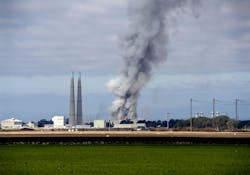After Massive Battery Storage Plant Blaze, Monterey County, CA, Advances Moratorium
Responding to a major fire in January at a battery storage plant in Moss Landing that sent a toxic cloud over a wide area and caused the evacuations of residents and the closure of Highway 1, the Monterey County Board of Supervisors late Tuesday took the first steps toward a ban on new battery plants in the county for a year or more while new safety rules are drafted.
Without comment, the supervisors allowed the proposal from Supervisor Glenn Church, whose district includes Moss Landing, to move forward. It requires the county staff in 30 days to draw up language for a moratorium on the construction of new plants or the expansion of existing ones, and deliver it to the supervisors for a vote.
“I’m trying to address a way for the county to have some input into sensitive areas like Moss Landing, but also elsewhere throughout the county,” Church said during the meeting.
Church said earlier this week that he hopes Monterey County will pass local rules affecting where battery storage plants can be built, fire safety, emergency management policies, and post-fire cleanup rules.
“We really need to have a set of ordinances that will address the health and safety of people in the community as well as the environment,” he added at Tuesday’s meeting.
A fire on Jan. 16 at the Moss Landing Plant — which is owned by Vistra, a Texas-based energy company — was the largest battery storage fire ever in the United States and made national news. It burned for two days, incinerating more than 50,000 batteries and sending a toxic cloud over Monterey Bay and nearby communities. Authorities evacuated 1,200 local residents, many of whom complained of headaches, breathing problems and other issues afterward. The fire raised questions about the safety of battery storage facilities that are being proposed and built across California and other states.
California has seen a massive increase in the growth of battery storage plants in recent years, going from 17 in 2019 to 187 today. Many more are planned across the Bay Area, in the Central Valley and Southern California.
The plants store electricity just like batteries in cell phones, laptops, or electric cars.
They essentially allow renewable energy to power the state 24 hours a day, making it a viable alternative to fossil fuels like natural gas and coal. The plants are needed to store electricity generated by large solar and wind farms to release it back on the power grid at night when the sun isn’t shining, or the wind isn’t blowing. California lawmakers have set a goal of generating 100% of the state’s electricity from renewable and carbon-free sources by 2045 to meet the state’s climate change and air pollution goals.
Community advocates near the Moss Landing site — which is still being demolished and cleaned up under supervision of the U.S. Environmental Protection Agency — say they support more local rules.
Another battery storage facility caught fire on Aug. 30 in Monterey County. In that blaze, at the California Flats Energy Storage Project, a solar farm near the rural community of Parkfield, led sheriff’s officials to issue an evacuation warning for people in a 2-mile radius of the blaze. It was extinguished within 24 hours.
Officials from Arevon, an Arizona company that owns the facility, said 4 of 84 Tesla battery packs at the site burned. The solar farm provides electricity to PG&E and Apple. There were no injuries.
Several other areas in California are moving forward with local regulation of battery plants.
Last year, Solano County, in the North Bay, approved a moratorium of new battery storage plants after residents raised safety concerns. In August, Solano County supervisors lifted it, but put in place new rules allowing the facilities to be constructed only on land zoned for industrial or manufacturing uses, rather than agriculture, residential or other uses.
Orange County officials enacted an emergency moratorium on new large-scale battery storage facilities in February, following the Moss Landing fire, while county officials there work with fire departments to draft new local regulations.
And Santa Cruz County is working on new rules as well that are expected to go before the board of supervisors in mid-November. A Massachusetts company, New Leaf, has proposed to build a 200-megawatt battery storage plant on Minto Road in Watsonville, near farm fields, homes and schools.
Local residents have organized to oppose it.
Renewable energy industry groups are opposing the moratoriums. They say the technology is critical for California to achieve its climate and renewable energy goals.
A preferable route, they say, is a model local ordinance for cities and counties that is being drafted by the Governor’s Office of Business and Economic Development, a state agency that promotes economic growth. They also note that Gov. Gavin Newsom last month signed a new law by State Sen. John Laird-D, Santa Cruz, that requires energy companies to meet with local fire officials when they are drafting emergency response plans, and to have the facilities inspected by them before they begin operation.
That measure, SB 283, was supported by renewable energy companies and labor unions, both of whom opposed more far-reaching proposals that died in the Legislature this year, such as attempts to ban the construction of battery plants within 3,200 feet of homes, schools, businesses and parks.
“Now is not the time to put up roadblocks to building vital clean energy resources,” said Scott Murtishaw, executive director of the California Energy Storage Alliance, an industry group whose members include Vistra, Tesla, Arevon and New Leaf.
©2025 MediaNews Group, Inc. Visit at mercurynews.com. Distributed by Tribune Content Agency, LLC.
